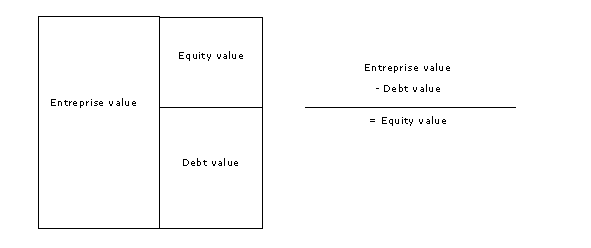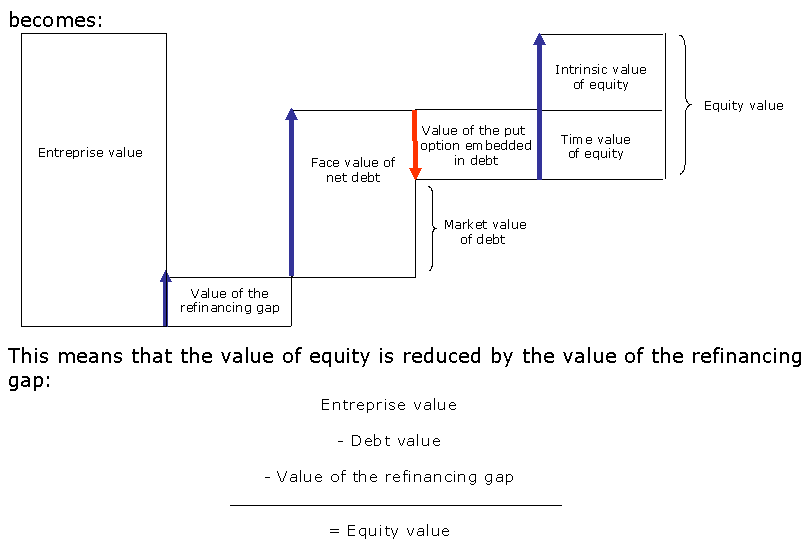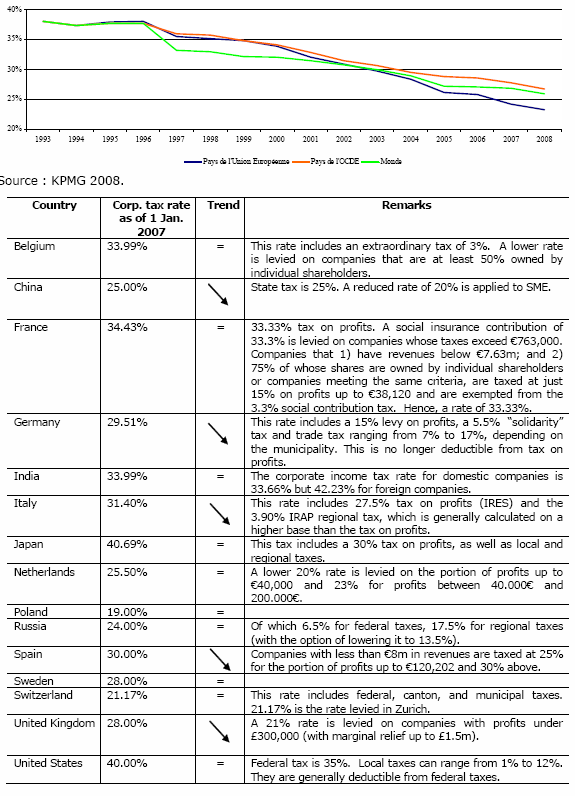Letter number 34 of September 2008
ALL ARTICLES
- TOPIC
- STATISTICS
- RESEARCH
- QUESTIONS & COMMENTS
News : Valuing liquidity risk
One of the upsides of a liquidity crisis is that it encourages us to take a new look at issues we think we understand but that suddenly start behaving in unexpected ways. One such issue is the impact of the announcement of a capital increase on the value of the shares of a company that is going through a tough time.
Since 1973 and the work done by Robert Merton which is based on the research carried out by Myron Scholes and Fisher Black, we have known that a share can be broken down into options. The same applies to debt.
A share is an option, held by the shareholder, to buy the operating assets of the company from the creditors at the debt repayment price. When the debt matures, if the entreprise value (i.e. the value of operating assets) is greater than the amount of debt that has to be paid back, the shareholders will ensure that the company pays off its debts (even if they have to carry out a capital increase for that purpose). They exercise their option to buy and, having paid off the lenders, the shareholders indirectly become the full and sole owners of the company's operating assets. If, on the other hand, the company's entreprise value is worth less than the value of the debts to be paid back, it would be in the shareholders' best interests to push the company into bankruptcy (by refusing to carry out capital increases to pay off its debts) and to let the lenders take over the operating assets, which they can then either manage better or liquidate. In this case, the shareholders will not have exercised their option to buy, but will in fact have exercised an option to sell the company's operating assets to the lenders for a price equal to the amount of debt that has to be paid back.
This is taking a rather simplified view of the matter (1) but it does explain why the share price of a company experiencing difficulties drops when a capital increase is announced, and why the bigger the company's problems, the more the share price will fall. If you have any doubts about the veracity of the above, just take a look at the recent share price performances of banks when they announced capital increases - Crédit Agricole: - 6 %, Fortis: - 19 %, etc.
What happens is that value is transferred from the shareholders to the creditors, the value of whose debts is enhanced by the capital increase. Robert Merton has shown that options can be used to quantify this transfer of value. The shareholder gains nothing in exchange for the drop in the time value of the optional component of the share triggered by the capital increase, because the increase in the intrinsic value of this component merely reflects the increase in the size of the shareholder’s investment in the company.
However, if we observe the situations of some companies in financial difficulty that have announced capital increases, we see that the above doesn’t provide a full explanation, given that sometimes the share prices rose (and didn’t fall) at the time of the announcement!
This is what happened for example when Altran Technologies announced a €130m capital increase on April 17, 2008, enabling it to lift the veil of uncertainty that was hanging over its ability to pay out its convertible bonds that will mature in January 2009 (€220m). The share price rose by 5.5% on the day of the announcement, and did not fall over the next two months, unlike the market index which fell by 9% over the same period.
It was public knowledge that for several months, Altran had been trying to find a way to stave off a potential liquidity crisis that could result from the short-term debt obligations it had to meet when it was not generating sufficient free cash flow to do so.
Given the liquidity risk (and thus the refinancing risk) taken by Altran, the share price was penalised by:
• uncertainty over its ability to secure refinancing
• uncertainty over the financial terms of this refinancing
In a recent study (2), Yann Aït-Mokhtar and the Exane BNP Paribas quantitative research team showed that this refinancing gap is like a swap between on the one hand, the short-term debt obligation and on the other, the free cash flow generated over the longer term by Altran’s capital employed. Some readers may be more inclined to think of it as an FRA (3). If you imagine that the duration of Altran’s free cash flow is five years, then it all happens as if Altran borrows for nine months to invest in its capital employed for five years. This amounts to investing in nine months for a period that lasts four years and three months. This is what’s known as an FRA (but also a swap agreement). Every swap agreement has a value and, in this sort of situation, the value is negative.
So, when a company faced with a liquidity problem, ie, a financing problem with debts that need to be paid off in a much shorter period than the time the company needs to generate cash, the standard model:
When Altran announces a capital increase, that is fully guaranteed by Apax, the value of the refinancing gap disappears because the liquidity gap disappears. This results in the first positive impact on the value of equity. At the same time, the value of its debt increases because Altran will have the means to repay it, triggering a second impact on the value of equity, which is negative this time, as identified by Robert Merton in 1973. All in all, if the value of the refinancing gap is greater than the discount on the debt, the announcement of a capital increase could result in an increase in the value of equity. The Altran case is the first example we have of this happening. The work done by Yann Aït-Mokhtar and his team enable us to explain and to come up with rough figures for the impact of liquidity problems on the value of equity.
(1) For more information, see chapter 35 of the Vernimmen.
(2) Cap Arb 2008, Hidden Value & Investment Opportunities, Exane BNP Paribas.
(3) Forward Rate Agreement, for more information, see chapter 48 of the Vernimmen.
Statistics : Corporate income taxes
Once again this year, KPMG’s annual study shows a decline in the average corporate income tax rate, to 25.9%, for all countries.
China, Germany, Italy, Spain and the United Kingdom significantly reduced their rates. For 2008, one can expect a pause as no major country has annouce a cut.
Research : The optimists
We thought that given the current environment, an article on optimism might be just what we all needed to cheer ourselves up!
For a long time, medical researchers have sought to determine the impact of psychological dispositions of individuals on their wellbeing. Increasingly, economists have started to look at their work and are studying the consequences of different psychological mindsets on behaviour. This month we take a look at the result of a study by two US economists (1) on the influence of optimism on economic choices made by individuals.
The authors relied on a wide-scale survey that has been carried out in the USA every three years since 1989 (Survey of Consumer Finances). A random sample of US citizens reply to a number of questions on themselves, their behaviour, their feelings and the economic situation.
Individuals are considered to be optimists if their stated life expectancy is greater than the figures in the mortality tables for their age group. For example, an individual with a life expectance of 78 based on his or her personal data, who expects to live to 82, will earn four optimism points.
This is more or less in line with standard methods for measuring optimism, such as expectations on how the economic situation will evolve.
The rest of the study shows how the degree of optimism influences economic, social and financial behaviour of individuals. We find that optimistic individuals are more likely to remarry after a divorce than those who are less optimistic. Optimists also work more days during the year and retire later than the gloomy. More generally, they tend to be much more positive about the future and accordingly, will take decisions now that will bring them greater wellbeing tomorrow. This also applies to their financial decisions. Optimists invest a larger amount of their savings in shares. They also tend to buy shared directly rather than through UCITS (unit trusts or mutual funds).
From the point of view of financial research, the most interesting point raised in this article is the distinction drawn between “moderately optimistic” individuals, whose economic behaviour is close to the theoretical optimum, and “extremely optimistic” individuals, whose behaviour can at times be irrational. Extreme optimists don't save at all, as they believe that no matter how they behave, everything will turn out well in the end. The authors refine the theories of overconfidence that have developed over recent years. Optimism will encourage economic rationality, and overconfidence only concerns a fraction of the 5% of the most optimistic Americans.
The conclusions to be drawn remain limited, by this vast field of research remains open should yield results that can be exploited for financial purposes in the years ahead.
(1) M.Puri and D.T.Robinson (2007), Optimism and Economic Choice, Journal of Financial Economics, vol.86-1, pages 71 to 99.
Q&A : New developments in M&A accounting
With a view to hastening the convergence of IFRS and US GAAP (1), the IASB has published a revised version of a IFRS 3 covering business combinations and IAS 27 (consolidated and individual financial statements). Subject to their (likely) adoption by the European Union, these revised standards will be applicable for European groups from the financial year commencing on June 30, 2009, but can be applied now if a company chooses to do so. However, it will not be necessary to adjust the accounting treatment of future operations.
Compared with the revolution brought about by IFRS 3 (no more depreciation of goodwill (2)), this revision is just what it claims to be, a revision, and it will not bring about any major changes in the field. The main changes are:
• the option, when a controlling stake is taken in a company, to book goodwill only on the part acquired (currently the case) or on 100% (as under the US rules, known as full goodwill). Those who are aware that the IASB is keen to reduce the number of options available in its standards will be surprised to see the introduction of this new option. It is in fact a compromise, as there were not enough proponents of booking full goodwill within the IASB to get it through. In the interests of convergence, however, there was a little bit of give and take. Using this method, the counterpart of a larger amount of goodwill is the amount of minority interests up to the share of total goodwill that does not go back to the parent company. The consequences of this are as follows: it increases the amount of capital employed booked, and thus, all other things being equal, reduces return on capital employed. Given the importance that groups place on this indicator of value creation (3), we can imagine that very few will be keen on this option. Additionally, if goodwill is depreciated at a later stage, the amount on the income statement will be higher since it will be increased by the amount of the minorities’s share in the goodwill. However, crucially the group’s net income share is not affected.
Finally, in the event of subsequent acquisition of all or some of the minority interests, and since the difference between their acquisition price and the amount recorded on the balance sheet will be deducted from the group’s share of equity, the full goodwill option will result in a smaller negative impact on equity as the minority interests would have been increased by the share of goodwill attached to them at the date of the initial acquisition.
• Any earn-out that had not been valued at its fair value on the date of the acquisition and that would be paid in the future following a period of 12 months running from the date on which goodwill was calculated, is booked on the income statement, which doesn't make for optimum transparency.
• If prior to the acquisition of a controlling interest, the acquirer already held a stake in the target, it is required, at the time of the acquisition, to register any capital gains in the income statement, as if the acquirer had sold this stake only to reaquire it immediately afterwards. Obviously, no financial director wants to see these capital gains on the income statement.
• The direct costs relating to the combination (investment bank and legal fees) are booked under expenses in the P & L and are not included in the calculation of goodwill.
• Fortunately nobody has actually ever died from giving something a silly name, because under the new rules, minority interests become “non-controlling interests”.
(1) For more see Vernimmen.com Newsletter n° 30 February 2008.
(2) For more information, see chapter 6 of the Vernimmen.
(3) For more information, see chapter 19 of the Vernimmen.



